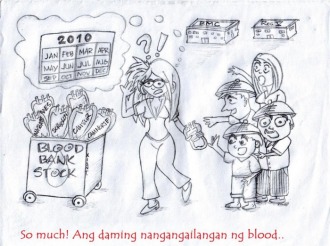EDITORIAL

The year 2009 is a significant year for the Blood Program because of the transitional period set by the World Health Organization and the Department of Health prior to the full implementation of the 100% Voluntary Blood Donation by 2010.
The Republic Act 7719 otherwise known as the “National Blood Services Act of 1994” was passed by the Philippine Congress and enacted by the Senate in 1994. The program is implemented by three players, namely: the Department of Health, the Philippine National Red Cross and the Philippine Blood Coordinating Council, with the World Health Organization setting its standards and quality assurance. Since then, the NVBSP had been struggling to come up with the best strategies and approach to promote and establish the blood program.
The Bicol Regional Blood Program, like in most part of the country has its share of ups and downs. Although we are seated on a much better position if not the best compared to any other Regional Blood Center in terms of percentage of voluntary blood collection, there is so much to be done and needed to reach the national goal in 2010. These are some of the compelling factor that makes the DOH-NVBSP appreciates the role of the BMC - NVBSP and the Regional Blood Center to the Blood Program.
Limited funds and resources are major issue that needs to be addressed. Furthermore, a Regional Collection target should be done to estimate the number of units needed in the Blood Service Facilities in the area. In relation, Naga City needs an estimated of at least 12,000 units annually. Collective efforts of the technical working personnel and network members for proper documentation and reporting shall be done in order to get the real perspective of the program.
The Bicol Medical Center Blood Bank and Transfusion Service had implemented the zero replacement policy and enforced the 100% voluntary blood collection since November 2008. It is ironic that other private hospitals within the network continue to entertain replacement and directed donation up to this date.
Another issue to be addressed is the component preparation and the appropriate use of blood by our dear physicians. This would in a way limit the unnecessary use and spoilage of blood and its component and promote rational use.
The Regional goal by 2010 of 100% voluntary blood donation needs much support and hard work. Zero replacement policy could only be done through a proper strategic planning and implementation. This should consider the Region’s geographic details, residents’ cultural diversity, resources at hand and political climate. A concerted effort to involve everyone in the community is much needed. It is only a few months before 2010 and the Department of Health’s goal maybe a dream to some, but achievable to most Camarinenses.
The Republic Act 7719 otherwise known as the “National Blood Services Act of 1994” was passed by the Philippine Congress and enacted by the Senate in 1994. The program is implemented by three players, namely: the Department of Health, the Philippine National Red Cross and the Philippine Blood Coordinating Council, with the World Health Organization setting its standards and quality assurance. Since then, the NVBSP had been struggling to come up with the best strategies and approach to promote and establish the blood program.
The Bicol Regional Blood Program, like in most part of the country has its share of ups and downs. Although we are seated on a much better position if not the best compared to any other Regional Blood Center in terms of percentage of voluntary blood collection, there is so much to be done and needed to reach the national goal in 2010. These are some of the compelling factor that makes the DOH-NVBSP appreciates the role of the BMC - NVBSP and the Regional Blood Center to the Blood Program.
Limited funds and resources are major issue that needs to be addressed. Furthermore, a Regional Collection target should be done to estimate the number of units needed in the Blood Service Facilities in the area. In relation, Naga City needs an estimated of at least 12,000 units annually. Collective efforts of the technical working personnel and network members for proper documentation and reporting shall be done in order to get the real perspective of the program.
The Bicol Medical Center Blood Bank and Transfusion Service had implemented the zero replacement policy and enforced the 100% voluntary blood collection since November 2008. It is ironic that other private hospitals within the network continue to entertain replacement and directed donation up to this date.
Another issue to be addressed is the component preparation and the appropriate use of blood by our dear physicians. This would in a way limit the unnecessary use and spoilage of blood and its component and promote rational use.
The Regional goal by 2010 of 100% voluntary blood donation needs much support and hard work. Zero replacement policy could only be done through a proper strategic planning and implementation. This should consider the Region’s geographic details, residents’ cultural diversity, resources at hand and political climate. A concerted effort to involve everyone in the community is much needed. It is only a few months before 2010 and the Department of Health’s goal maybe a dream to some, but achievable to most Camarinenses.
